Click on any researcher’s name to access their laboratory’s Web site.
Chair of Systems and Control
We conduct educational research into new hardware technology that use electrical devices/systems and communication networks to aid and assist the lives of people with disabilities.
OHKAWA Masashi, Professor
Optical integrated-circuit microphone
Magnetic resonance imaging (MRI) is able to provide non-invasive cross-sectional images of the body but requires a magnetic field in the vicinity of 1 Telsa (about 20,000 times stronger than the earth’s magnetic field). This enormous magnetic field makes it impossible for doctors and technicians to communicate with patients in the MRI room with ordinary microphones. The optical integrated-circuit microphone that our laboratory is developing can be used in MRI rooms because it uses no metal and, thus, is not affected by magnetism. Optical integrated circuits realize their intended functions with light instead of electricity. The circuit’s optical components such as mirrors and semi-transmissive mirrors are formed on substrates of glass or semiconductors. Our aim is to contribute to society by applying this kind of optical integrated-circuit technology to the medical and security fields.
MIMURA Nobuharu, Professor
Our research field is mechatronics — the control of machines and mechanical devices. Our primary interest is how to provide mechanical devices with the intelligence to perform operations as sophisticated as humans can. Our scope extends from basic analysis work and numerical simulations to building the hardware and making it actually move. We welcome people with a positive mindset and the perseverance to tackle anything without fear of failure.
Research Themes:- Development and application of articulated robotic hands
- Development and application of new robot architectures (parallel link mechanisms)
- Development and application of kinesthetic sensors
- Development and application of robot aircraft (helicopter)
WATANABE Tetsuya, Associate Professor
In everyday life, we encounter many kinds of aids for visually impaired persons such as audible signals at crosswalks, tactile paving, Braille text, and white canes. Besides them, visually impaired persons use many other ICT devices at home and in the workplace, such as computers with screen reading software, OCR software, automatic Braille transcribing software, OCR software, and screen magnifiers. We study, research, and develop these types of useful, practical devices, software, and systems. For more details, take a look at our laboratory Web site.
Research Themes:- Research and development of a tactile map creation system
- Research and development of tactile display systems
- Research into Braille training aids
- Development and enhancement of screen readers
- Research into easy-to-understand kanji character explanations
- Research into easy-to-understand phonetic readings
- Survey on computer and mobile-phone usage by the visually impaired
- Web accessibility survey
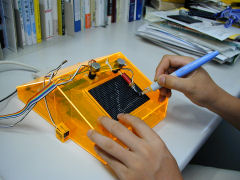
Photo 1: A tactile display that enables visually impaired people to draw.
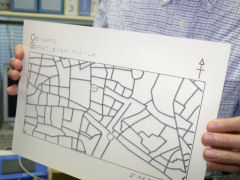
Photo 2: A tactile map for visually impaired persons.
MIMURA Nobuharu, Associate Professor
.
Research Themes:Chair of Biomedical Engineering
We conduct educational research into functional physiology, biological engineering, and technologies to process biological information in pursuit of forming more natural relationships between humans and devices.
HAYASHI Toyohiko, Professor
The Hayashi Laboratory has three research areas examining assistive engineering, motion analysis, and biomechanisms. What sets our research apart is that all research is conducted jointly with other departments or with external organizations (other universities, corporations, organizations for supporting the disabled). See each researcher's Web page for more details.
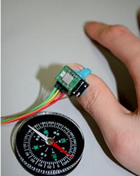
Photo 1: Omnidirectional, no-load control switch that uses a triaxial magnetic sensor.
The assistive engineering team is working on (1) the development of communication-assistive devices, (2) the development of control switches that can be used in diverse environments and research into user-interface operability, and (3) the development of larynx-motion detection systems to monitor the swallowing function and for rehabilitation. Photo 1 shows one type of control switch we are developing. A triaxial magnetic sensor measures the earth’s local magnetic field and senses deviations in the lines of magnetic forces caused by finger movement. The magnetic deviations are used to operate the switch. What is special about this switch is that it senses movement in all directions and puts absolutely no load on the user.
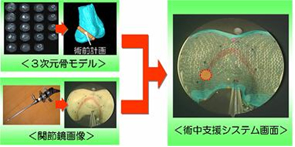
Photo 2: Perioperative navigation system for arthroscopic surgery.
The motion analysis team is working on (1) analysis of sports movements (kicks in soccer and pitching in baseball), (2) research into the stability and shock absorption of running shoes, (3) usability testing of universal design products and health appliances, and (4) the development of systems to assist arthroscopic surgery. Photo 2 depicts a system used to assist restorative anterior cruciate ligament (ACL) surgery. The system indicates to the surgeon the position of the foramen where the ligaments are inserted by superimposing in real time a computer model of the bone structure over the arthroscopic images.
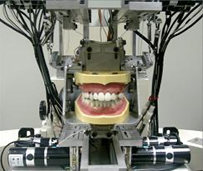
Photo 3: JSN/2 autonomous jaw movement simulator.
The biomechanism team is working on (1) the development of the JSN/2 jaw movement simulator, (2) the development of the SKN/1 robotic shoulder motion simulator, and (3) a 3D motion analysis of the shoulder joint using OpenMRI system. Photo 3 shows the JSN/2 autonomous jaw movement simulator, which is being used to unravel the underlying mechanisms of jaw movement. We are currently analyzing the various bite mechanisms that differ according to the food particle size and texture.
HORI Junichi, Professor
We are engaged in research in the areas of biomedical engineering and assistive technology. Our research interests include analysis of biomedical signals, such as electroencephalograms, electrooculograms, electromyograms, and medical images, and we are working on developing high-performance medical instruments and assistive devices. One example is a communication device that lets users control a computer with just their thoughts without moving their legs or arms. At the root of our research topics are so-called “inverse problems.” In other words, we expect to be able to discover the substance of the issue at hand from measured signals and images by solving the inverse problem.
Research Themes:- Brain functional analysis from EEG measurement
- Inverse problems of brain electrical sources (human brain mapping)
- Brain-computer interfaces
- Development of communication-assistive devices using eye movement
- Bio-signal interface such as EEG, EOG, and EMG
- High-precision measurements of bio-signals (electrocardiograms, blood pressure, etc.)
- Restoration and reconstruction of blurred or low resolution medical images
- Analysis of dynamic characteristics while operating manual wheelchairs
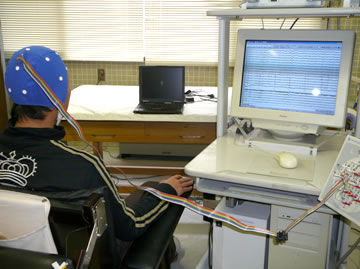
Photo: A brain-computer interface experiment.
ISHII Nozomu, Associate Professor
Research into the calibration of SAR probes for mobile devices.
Specific absorption rate (SAR) is a measure of the rate at which energy is absorbed by the body per mass of tissue when exposed to a radio frequency electromagnetic field. If you are interested, check the SAR value of your mobile device on your mobile phone carrier’s Web site. In anticipation of the higher frequencies mobile phones and other devices will use in the future, our laboratory is working to establish a calibration method for SAR probes with the goal of proposing a calibration standard to a committee in IEC (International Electrotechnical Commission). More specifically, we are developing a reference antenna to determine the electric field in an equivalent liquid that simulates the head and studying ways of measuring the gain of the reference antenna in the liquid. Although measurements are complicated by the fact that RF electromagnetic waves are hugely attenuated within liquids, we are searching for a solution through careful study of RF electromagnetic wave behavior and use of novel measurement systems.
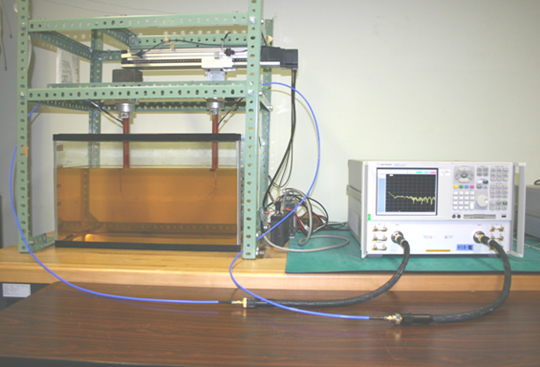
Photo: Gain measurement system for antennas immersed in a liquid.
MAEDA Yoshinobu, Associate Professor
Assistive Engineering and Socio-/Bio-system simulation laboratory
“Man is but a reed, the most feeble thing in nature, but he is a thinking reed.” Pascal’s famous statement is considered to be a kind of model expressing reality by simplifying that elaborate system known as man. Of course, well before Pascal Aristotle developed the model that “man is by nature a social animal,” and yet others agree with Bertrand Russell who said that humans exist half socially and half in isolation. At the Assistive Engineering and Socio-/ Bio-System Simulation Laboratory, we develop models for social and biological phenomena using such engineering techniques as equations, circuits, and programs and then conduct research using these models to probe deeper into the essence of social and biological phenomena. For example, models that recreate neuron activity with electronic circuits and computer models of the class’s friendships have uncovered some completely unexpected and fascinating phenomena. Our objective is to clarify the rules concealed in the background of these phenomena. And in cooperation with the Niigata Prefectural Association of the Visually Impaired, we teach the visually impaired how to use computers. Students interested in teaching computers can participate as teaching assistants.
Research Themes:- Analytic simulations of biological information processing systems using circuit models
- Analysis of social information systems using geographical information systems (GIS)
- Development of an AHP-GIS system that helps visually impaired people determine their travel routes
- Simulations of social issues such as bullying and social disparities
- Research into human interfaces for assisted living
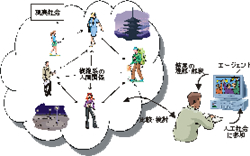
Figure 1: Diagram of a participative agent simulation.
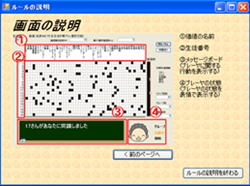
Figure 2: Description page of a participation-type artificial class game.
IIJIMA Atsuhiko, Associate Professor
Graduate School of Science and Technology
KIRYU Tohru, Professor
NeuroEngineering Approach for Assistive Technology
NeuroEngineering approach for assistive technology is aiming to support proper exercise with sensory stimuli by monitoring neuromuscular and sense system. To evaluate the effects, assessment of autonomic nervous regulation is additionally important. On-site ubiquitous biosignal measurement via information technology and analysis based on history database allow this type of approach. Our team has studied several exercises including walking, cycling, and skiing. Besides, for application of virtual environment technology to possible motor rehabilitation we have also evaluated the influences related to enhancing a specific sensory stimulus, which sometimes causes unpleasant sensations or fatigue, and in turn decreases motivation for continuous rehabilitation. Our goal of neuroengineering approach for assistive technology is “Walk Again.” Let’s join us to achieve this goal.
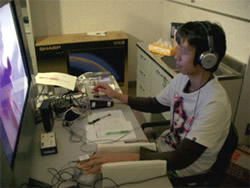
Photo 1: Assessment of the influences of visually induced feeling of motion.
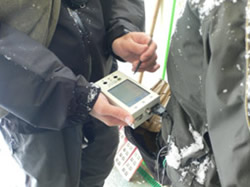
Photo 2: Measuring the effect of muscle fatigue on motor performance
(Skiing experiments).
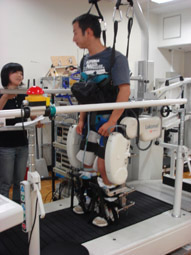
Photo 3: Aiming for Walk Again
(at the Research Institute of the National Rehabilitation Center for Persons with Disabilities).
IWAKI Mamoru, Associate Professor
Sound is an essential information media for people. Although, unlike visual media, sound is only one dimensional, our hearing has the ability to produce spatial sensations and we are able to selectively hear certain sounds. These functions operate at an unconscious level in our daily lives. Hearing is a remarkable ability built into humans. Our laboratory looks at the problems of waveform analysis, recognition, and generation from a theoretical perspective as well as develops and implements engineering models of auditory functions. We also research the design of practical digital filters.
Research Themes:- Methods of identifying, analyzing, and synthesizing voice characteristics
- Measurement and engineering application of the psychophysical characteristics of hearing
- Relationship between auditory stimuli and biofunctional signals
- Voice and hearing quality evaluations
- Methods of analyzing instantaneous waveform characteristics using the natural observation method
- Methods of designing digital filters